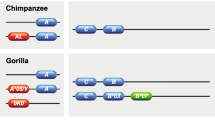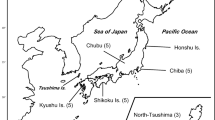Abstract
The major histocompatibility complex (MHC) is highly polymorphic in most primate species studied thus far. The rhesus macaque (Macaca mulatta) has been studied extensively and the Mhc-DRB region demonstrates variability similar to humans. The extent of MHC diversity is relatively unknown for other Old World monkeys (OWM), especially among genera other than Macaca. A molecular survey of the Mhc-DRB region in mandrills (Mandrillus sphinx) revealed extensive variability, suggesting that other OWMs may also possess high levels of Mhc-DRB polymorphism. In the present study, 33 Mhc-DRB loci were identified from only 13 animals. Eleven were wild-born and presumed to be unrelated and two were captive-born twins. Two to seven different sequences were identified for each individual, suggesting that some mandrills may have as many as four Mhc-DRB loci on a single haplotype. From these sequences, representatives of at least six Mhc-DRB loci or lineages were identified. As observed in other primates, some new lineages may have arisen through the process of gene conversion. These findings indicate that mandrills have Mhc-DRB diversity not unlike rhesus macaques and humans.









Similar content being viewed by others
References
Antunes SG, de Groot NG, Brok H, Doxiadis G, Menezes AA, Otting N, Bontrop RE (1998) The common marmoset: a New World primate species with limited Mhc class II variability. Proc Natl Acad Sci USA 95:11745–11750
Bassam BJ, Caetano-Anolles G, Gresshoff PM (1991) Fast and sensitive silver staining of DNA in polyacrylamide gels. Anal Biochem 196:80–83
Beck S, Trowsdale J (2000) The human major histocompatibility complex: lessons from the DNA sequence. Annu Rev Genomics Hum Genet 1:117–137
Blankenburg A, Kaup FJ, Sauermann U (2003) Mhc class II DRB sequences of lion-tailed macaques (Macaca silenus). Tissue Antigens 62(3):267–269
Bontrop RE, Otting N, de Groot NG, Doxiadis GG (1999) Major histocompatibility complex class II polymorphisms in primates. Immunol Rev 167:339–350
Brown JH, Jardetzky T, Gorga JC, Stern LJ, Urban RG, Strominger JL, Wiley DC (1993) Three-dimensional structure of the class II histocompatibility antigen HLA-DR1. Nature 364:33–39
de Groot N, Doxiadis GG, de Groot NG, Otting N, Heijmans C, Rouweler AJM, Bontrop RE (2004) Genetic makeup of the DR region in rhesus macaques: gene content, transcripts, and pseudogenes. J Immunol 172:6152–6157
Doxiadis GGM, Otting N, De Groot NG, Bontrop RE (2001) Differential evolutionary MHC class II strategies in humans and rhesus macaques: relevance for biomedical studies. Immunol Rev 183:76–85
Doxiadis GGM, Otting N, De Groot NG, De Groot N, Rouweler AJ, Verschoor EJ, Bontjer I, Bontrop RE (2003) Evolutionary stability of the MHC class II haplotypes in diverse rhesus macaque populations. Immunogenetics 55(8):540–551
Gyllensten UB, Sundvall M, Ezcurra I, Erlich HA (1991) Genetic diversity at class II DRB loci of the primate MHC. J Immunol 146:4368–4376
Hughes AL, Nei M (1989) Nucleotide substitution at major histocompatibility complex class II loci: evidence for overdominant selection. Proc Natl Acad Sci USA 86:958–962
Jukes TH, Cantor CR (1969) Evolution of protein molecules. In: Munro HN (ed) Mammalian protein metabolism. Academic, New York, pp 21–132
Klein J (1987) Origin of major histocompatibility complex polymorphism: the trans-species hypothesis. Hum Immunol 19:155–162
Klein J, Figueroa F (1986) Evolution of the major histocompatibility complex. CRC Crit Rev Immunol 6:295–386
Klein J, O’hUigin C (1994) MHC polymorphism and parasites. Philos Trans R Soc Lond B 346:351–358
Klein J, Satta Y, O’hUigin C, Takahata N (1993) The molecular descent of the major histocompatibility complex. Immunol Rev 11:213–244
Knapp LA, Cadavid LF, Eberle ME, Knechtle SJ, Bontrop RE, Watkins DI (1997) Identification of new Mamu-DRB alleles using DGGE and direct sequencing. Immunogenetics 45:171–179
Kriener K, O’hUigin C, Tichy H, Klein J (2000) Convergent evolution of major histocompatibility complex molecules in humans and New World monkeys. Immunogenetics 51:169–178
Kumar S, Tamura K, Nei M (1993) Molecular evolutionary genetics analysis. Pennsylvania State University, University Park
Leuchte N, Berry N, Köhler B, Almond N, LeGrand R, Thorstensson R, Titti F, Sauermann U (2004) MhcDRB-sequences from cynomologus macaques (Macaca fascicularis) of different origin. Tissue Antigens 63:529–537
Marsh SG, Albert ED, Bodmer WF, Bontrop RE, Dupont B, Erlich HA, Geraghty DE, Hansen JA, Hurley CK, Mach B, Mayr WR, Parham P, Petersdorf EW, Sasazuki T, Schreuder GMTh, Strominger JL, Svejgaard A, Terasaki PI, Trowsdale J (2005) Nomenclature for factors of the HLA system, 2004. Tissue Antigens 65:301–369
Nei M, Gojobori T (1986) Simple methods for estimating the number of synonymous and nonsynonymous nucleotide substitutions. Mol Bio Evol 3:418–426
O’hUigin C (1995) Quantifying the degree of convergence in primate MHC-DRB genes. Immunol Rev 143:123–140
Paz-Artal E, Corell A, Varela P, Martinez-Laso J, Gomez-Casado E, Fernandez-Soria VM, Moreno MA, Arnaiz-Villena A (1996) Primate DRB6 gene expression and evolution: a study in Macaca mulatta and Cercopithecus aethiops. Tissue Antigens 47:222–227
Penedo MCT, Bontrop RE, Heijmans CMC, Otting N, Noort R, Rouweler AJM, de Groot NG, Ward T, Doxiadis GGM (2005) Microsatellite typing of the rhesus macaque MHC region. Immunogenetics 57(3–4):198–209
Riess O, Kammerbauer C, Roewer L, Steimle V, Andreas A, Albert E, Nagai T, Epplen JT (1990) Hypervariability of intronic simple (gt)n(ga)m repeats in HLA-DRB genes. Immunogenetics 32:110–116
Robinson J, Waller MJ, Parham P, de Groot N, Bodmer JG, Kennedy LJ, Stoehr P, Marsh SGE (2003) IMGT/HLA and IMGT/MHC: sequence databases for the study of the major histocompatibility complex. Nucleic Acids Res 31:311–314
Slierendregt BL, van Noort JT, Bakas RM, Otting N, Jonker M, Bontrop RE (1992) Evolutionary stability of trans-species major histocompatibility complex class II DRB lineages in humans and rhesus monkeys. Hum Immunol 35:29–39
Trowsdale J (1996) Molecular genetics of HLA class I and class II regions. In: Browning MJ, McMichael AJ (eds) HLA and MHC: genes, molecules and function. BIOS Scientific, Oxford, pp 23–38
Wickings EJ, Dixson AF (1992) Application of DNA fingerprinting to familial studies of Gabonese primates In: Martin RD, Dixson AF, Wickings EJ (eds) Paternity in primates: genetic tests and theories. Karger, Basel, pp 113–130
Zhu ZF, Vincek V, Figueroa F, Schönbach C, Klein J (1991) Mhc-DRB genes of the pigtail macaque (Macaca nemestrina): implications for the evolution of human DRB genes. Mol Biol Evol 8(5):563–578
Acknowledgements
We thank the CIRMF staff and the Chester Zoo for their assistance in providing DNA samples. The authors would also like to thank the three anonymous reviewers for their comments. This work was funded in part by the Leverhulme Trust, the American Society of Primatologists and the Cambridge Philosophical Society.
Author information
Authors and Affiliations
Corresponding author
Rights and permissions
About this article
Cite this article
Abbott, K.M., Wickings, E.J. & Knapp, L.A. High levels of diversity characterize mandrill (Mandrillus sphinx) Mhc-DRB sequences. Immunogenetics 58, 628–640 (2006). https://doi.org/10.1007/s00251-006-0132-3
Received:
Accepted:
Published:
Issue Date:
DOI: https://doi.org/10.1007/s00251-006-0132-3




